Mercedes Double DRS (DDRS)
It wouldn’t be the start of a Formula One season without some controversy over a new clever bit of technology designed to make cars go faster. It was same at beginning of 2012 season. This time Mercedes AMG produced a novel, somebody call it front 'F-duct' and somebody “W-duct”, but "officially" is DDRS system, utilizing the DRS activation mechanism on the Mercedes W03 and designed to give the car a straight line speed and braking advantage, and it was causing controversy at the season-opening Australian GP.
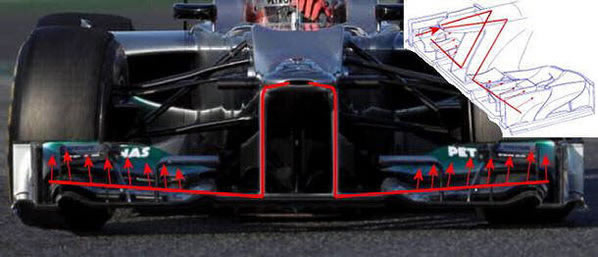
In Japan last year the team tested their new secret weapon aimed for next season, a passive system that fed air through the nose cone vent and down the two wing pillars to the front-wing flap. But it proved difficult to set up, and with the nose cone vent now only allowed to be used for driver cooling, they had to find a different way to get the airflow to the front wing. The Finnish broadcaster MTV3, describing the system as ‘W-duct’, has provided some detail as to how it works. ‘W-duct’ name actually describing air flow from nose tip hole, normally used for driver cooling, trough both wing pylons and is dispersed in a W-like pattern across the underside length of the front wing. Unlike the driver-operated rear wing F-duct, which was banned for 2011, Mercedes’ system was entirely passive and requires no moving parts or driver interaction, and it was therefore legal.
For the first race of 2012 season Mercedes improved their system. It is not anymore completely passive, and system is activated by and linked to DRS. System is basically DRS-operated speed boost system. This uses the opening of the DRS flap on the rear wing to open a duct that sends high pressure air to other parts of the car, specifically to the front wing underside.
Some teams, read Lotus and Red Bull, protested the system as illegal and against the spirit of the rules regulating movable aerodynamic surfaces and a rule that prohibits drivers altering aerodynamics. The system operates in conjunction with the DRS (drag reductio system) overtaking aid, which most teams understood to be limited to operation on the rear wing. The argument has become particularly contentious because Mercedes have raised their competitiveness after two difficult seasons and are now contenders at the front.
After Melbourne race protest, FIA has allowed the system because race director Charlie Whiting felt that it was simply an extension of the DRS and that it was impossible to draw a line saying it was not allowed.
His view is that the driver can affect the aerodynamics as long as it is only for the operation of the DRS - and the Mercedes system is part of the DRS.
The contrary argument is that this is an illegal secondary system that is activated by the driver when he uses the DRS. In simple terms, the system cannot work unless the driver hits the DRS button therefore it is driver controlled.
Whiting feels that as the team are reducing drag - albeit elsewhere on the car than was originally intended by the DRS system - it should be allowed.
Mercedes argue that the “W-Duct” system is automatic and the driver does not control it therefore they consider it legal.
Either way, the grey areas in terms of legality are whether it is considered to be passive in its operation – legal, or driver operated - not legal, and whether it is acceptable for the driver-operated DRS mechanism to have such a secondary function.
And this secondary function is an interesting thing.
This brings up the designers favorite interpretation in the rule book, “Primary and Secondary Purpose”. Any part on the car is made for some primary purpose. Designers always try to find secondary, useful purpose for device in question. Sometimes any secondary purpose is banned or restricted. However in most cases the rules are vague and designers are free to find secondary uses for a solution on the car. Always the Primary purpose is legal, but a secondary purpose is there to be found and exploited. Good example is blown diffuser. Exhaust gases primary and secondary purpose. Another good example is engine on the over-run. In Press Conference at Monaco 2011, Newey tried to defend the legality of exhaust-blown diffusers on the over-run, by claiming that the primary function of an open throttle on the over-run is to cool the exhaust valves. (And secondary function is well used!)
Finally, before third race 2012 China Grand prix, Lotus become the first to formally lodge a protest against the controversial DDRS wing.
"Lotus F1 Team Team, by means of this document, formally files a protest concerning the Scrutineers of the Meeting's decision regarding Cars No: 7 and 8 on 12th April 2012, relating to their conformation to article 3.15 of the 2012 Technical Regulations," the team said in a statement.
"This protest is pursuant to Articles 171-179b) (chapter XII) of the FIA International Sporting Code. A deposit for the amount of €2,000 has been lodged with the FIA in anticipation of this protest. The FIA is hereby authorized to use this deposit as the fee for this protest in accordance with Article 17.1 of the 2012 Formula One Sporting Regulations.
Lotus argued that Mercedes' new wing, which stalls the front and rear wings for added straight-line, is illegal under article 3.15 of the technical regulations.
"With the exception of the parts necessary for the adjustment described in Article 3.18 (DRS system), any car system, device or procedure which uses driver movement as a means of altering the aerodynamic characteristics of the car is prohibited," the rules sate.
However, the stewards did not agree with Lotus' argument and unanimously dismissed the protest.
According to the FIA statement, it was deemed that “the Mercedes design is not activated by driver movement”.
“It is a consequence of a change of position of the driver adjustable bodywork, which is permitted under the regulations.”
As to the other main point of contention, the FIA stated that while "the Mercedes design does appear to alter the aerodynamic characteristics of the car by reducing the drag" that "this is consistent with the intent of the regulations."
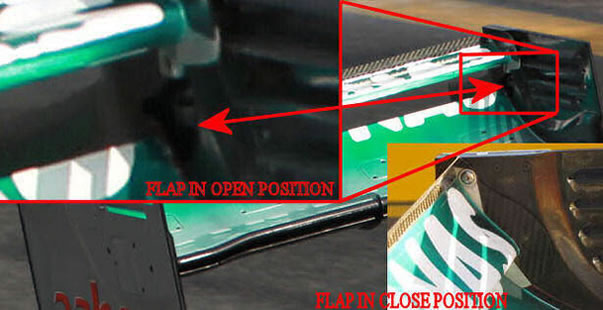
All cars have the DRS - which moves a flap on the rear wing to reduce drag and therefore increase straight-line speed. On the Mercedes, the flap moves in the same way as on all the other cars, no difference. But when the DRS flap opens on the 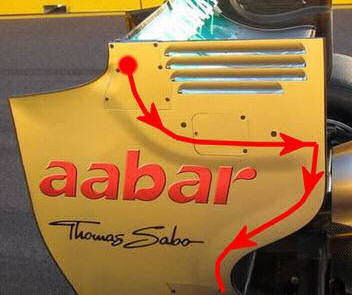 Mercedes, it reveals a holes on the inboard side of the both end plates, into which the air flows, before being directed down through the hollow wing end plates, along the lower beam wing, through some pipes and ducting in the engine space and the cockpit, trough nose cone, down the front wing pillars, into the front wing and and emerges under the front wing out of a slots and thus stalls the front wing when the DRS is open. Holes on the rear wing end plates are located in high pressure area, on the upper side of the rear wing main plane and that would force flow through the duct. Only the pressure of sucked air will be enough, but the low-pressure air under the front wing will help and suck air through the car ducting from the rear wing, reducing the effectiveness of the front wing. That has two effects.
Mercedes, it reveals a holes on the inboard side of the both end plates, into which the air flows, before being directed down through the hollow wing end plates, along the lower beam wing, through some pipes and ducting in the engine space and the cockpit, trough nose cone, down the front wing pillars, into the front wing and and emerges under the front wing out of a slots and thus stalls the front wing when the DRS is open. Holes on the rear wing end plates are located in high pressure area, on the upper side of the rear wing main plane and that would force flow through the duct. Only the pressure of sucked air will be enough, but the low-pressure air under the front wing will help and suck air through the car ducting from the rear wing, reducing the effectiveness of the front wing. That has two effects.
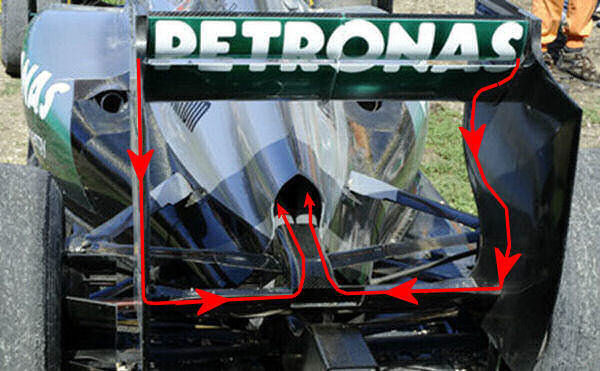
It cuts drag (in the same way as „F-duct“ system used by the teams two years ago, with air flowing from the nose, through the monocoque, to the rear wing, but in this case in opposite way), therefore boosting straight-line speed even more than it already would be just by opening the DRS flap.
But it also makes the car more balanced front to rear in high-speed corners in practice and qualifying, where DRS use is free, because the main problem with F1 cars in fast corners with DRS activated is that they have too much front downforce, and that will increase oversteer - which is instability at the rear of the car. That can limit how fast a driver can go through the bend.
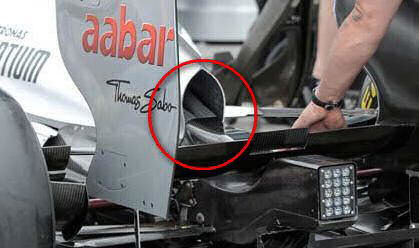 Because the Mercedes system reduces front downforce too, that means their car can maintain a consistent balance while also benefiting from the top-speed boost of the DRS and stalled front wing. When the DRS are deactivated, the airflow stops. But, maybe a specific characteristic of the system could hurt Mercedes a bit. When the DRS closes airflow stops, but because there is still some air in the system, and this air still flowing and staling front wing, the rear downforce comes back on to the car quicker than the front downforce. It might only be a 10th of a second or less - but it does mean the rear of the car is stable earlier.
Because the Mercedes system reduces front downforce too, that means their car can maintain a consistent balance while also benefiting from the top-speed boost of the DRS and stalled front wing. When the DRS are deactivated, the airflow stops. But, maybe a specific characteristic of the system could hurt Mercedes a bit. When the DRS closes airflow stops, but because there is still some air in the system, and this air still flowing and staling front wing, the rear downforce comes back on to the car quicker than the front downforce. It might only be a 10th of a second or less - but it does mean the rear of the car is stable earlier.
Also, they must have some kind of restrictor in there that they can change from track to track depending on track characteristics. Some rivals estimate the system could be worth as much as 0.5 seconds a lap during practise and qualifying.
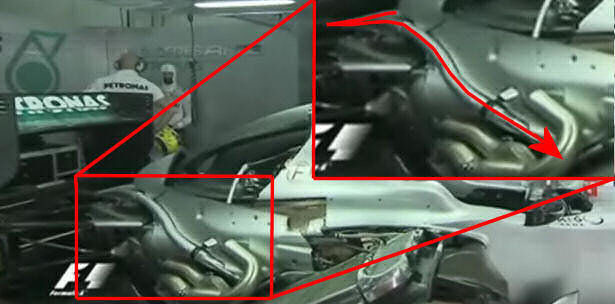
How Mercedes managed to link rear wing with the front of the car? Some pictures have emerged partially showing how.
Mercedes fitted their DRS actuation system in the rear-wing end plates, which is what allows them to have the hole in the end plate in first place, which is otherwise illegal. This hole primary purpose is to allow DRS actuation system levers to connect to the wing flap. This hole is made unusually big, and with DRS closed, this hole is covered.
When the driver has the DRS flap closed on the rear wing, the front and rear wings operate as usual. Both wings create downforce in the usual way.
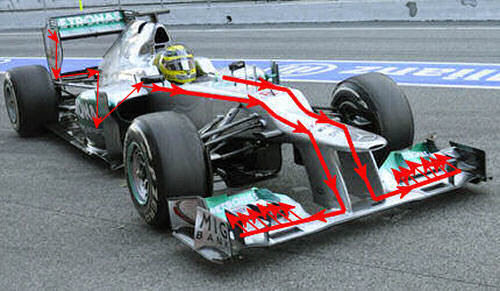
When the driver opens DRS, the flap uncovers a pair of openings on the rear wing end plates. These openings are fed with high pressure air. There is a duct inside the unusually thick end plates, and that is feeding the DRS-duct system.
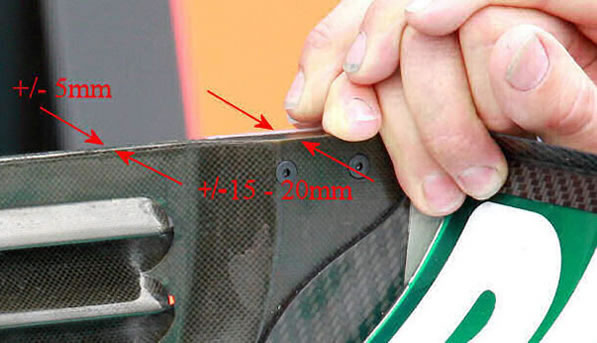
The air flow around wing end plates towards the beam wing. The airflow then passes inside the beam wing, passes to a bulged fairing with two ducts and disappear inside the engine cover. On the picture before, you can see two ducts, but there is possibility that these ducts are linked together to balance the system pressure, as in yaw or side wind one duct might not have the same pressure feed as the other.
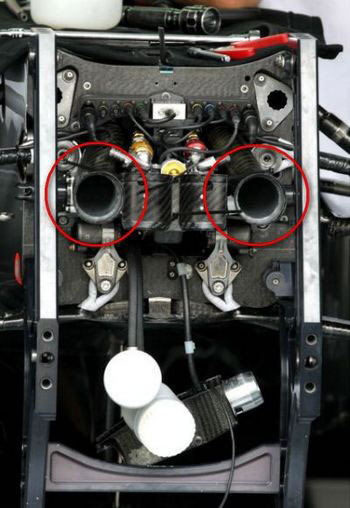 Picture up shows a duct passing the engine bay. On either side of engine is a same ducting. In picture we can see ducts disconnected from the beam wing. Ducts are passing engine bay to the rear monocoque bulkhead. Looks like ducting is passing below or low near the fuel tank. Pictures of duct routing after bulkhead are still not available, but I assume they pass outside the fuel tank area and into the cockpit, where they then pass along the roof or sides of the footwell to emerge at the front bulkhead. This pipe routing within the tight confines of the car probably explains why two ducts are used and not one larger duct.
Picture up shows a duct passing the engine bay. On either side of engine is a same ducting. In picture we can see ducts disconnected from the beam wing. Ducts are passing engine bay to the rear monocoque bulkhead. Looks like ducting is passing below or low near the fuel tank. Pictures of duct routing after bulkhead are still not available, but I assume they pass outside the fuel tank area and into the cockpit, where they then pass along the roof or sides of the footwell to emerge at the front bulkhead. This pipe routing within the tight confines of the car probably explains why two ducts are used and not one larger duct.
On picture with the nose cone removed we can see the front bulkhead area. We can see two tubes, exiting footwell area and entering nose cone. They are feeding the flow into the front wing trough the nose cone. When the nose cone is fitted, these ducts connect with corresponding holes and ducting inside the nose cone to pressurize the nose. This in turn feeds the airflow down the front wing pylons to the front wing. For now, no pictures of inside of nose cone are available.
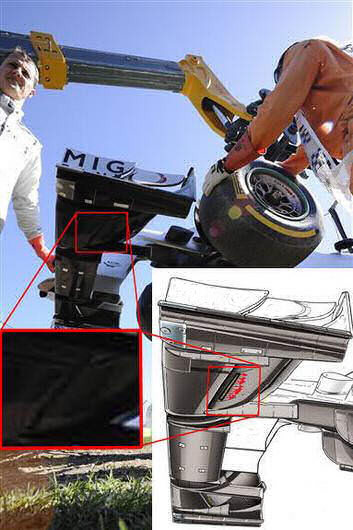
Underneath the front wing there is a pair of slots, one on each side. When DRS is open the flow through the ducts blows through these slots and stall the front wing in same way “F-Duct” does with rear wing. We can see from picture of the Schumacher car in Melbourne, that there are slots under the front wing.
But, can this be legal? Strictly by the rules it is. Stalling a front wing through a blown slot is legal. Although F-ducts are banned, it’s only because the slot in the rear wing are banned. Direct driver intervention is banned, but the driver is allowed to operate the DRS, so any secondary aerodynamic effect of that is not prohibited in the rules.
Rivals say that a system is unlawful.
Unless it's banned, the others will probably all have something similar soon - but it's a very expensive thing for a small gain.
For rival teams to replicate this system, they will need to find space to package the ducts inside the footwell area. As we saw in 2010 with “F-duct”, teams can be very imaginative in creating way to package this sort of solution. But this will take time and may explain some team’s opposition to the legality of the system.
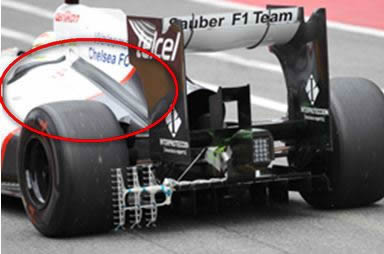 During May 2012 in-season test in Mugello, Italy, Sauber ran with external piping on its C31 during testing, which prompted speculation that it could have been evaluating the double DRS further. Sauber chief designer Matt Morris said early analysis by his outfit had left it feeling that it would be better off devoting resources to finding more normal development progress. "We have done some evaluation on it in the factory, but at the moment it's not really working for us in terms of cost versus performance. It's definitely a few tenths of a second in qualifying, but to get that [benefit] so many parts in the car would have to be changed. That's the problem. It's difficult to know exactly the potential benefits and then it's only really useful in qualifying as well."
During May 2012 in-season test in Mugello, Italy, Sauber ran with external piping on its C31 during testing, which prompted speculation that it could have been evaluating the double DRS further. Sauber chief designer Matt Morris said early analysis by his outfit had left it feeling that it would be better off devoting resources to finding more normal development progress. "We have done some evaluation on it in the factory, but at the moment it's not really working for us in terms of cost versus performance. It's definitely a few tenths of a second in qualifying, but to get that [benefit] so many parts in the car would have to be changed. That's the problem. It's difficult to know exactly the potential benefits and then it's only really useful in qualifying as well."
Mercedes team principal Ross Brawn says there is so much opposition to the team's DRS system because it is difficult to integrate it into a car that was not designed from scratch with the system in mind. Because the air flow is channeled from the rear wing back to the front wing the whole structure needs to pass along the length of the car, and Brawn said the difficulty in packaging it has caused teams to mount a more sustained challenge. A number of Brawn's rivals have suggested that it would cost a fortune for them to incorporate a DRS-activated F-duct system on to their cars - at a time when teams are facing budget concerns. Brawn said. “It's a very simple, cheap system, but not so easy to implement if you haven't integrated it into your car. This is at the heart of the frustration of some of our opponents. If someone could put it on their car easily, I promise you we wouldn't be having these discussions. But they can't do it very easily, which is why they're getting so vexed about it.” “People (other F1 teams) talk about the huge cost, but there is no huge cost. There are a couple of carbon pipes running down the car. The man in the street would tell you they are a few thousand pounds, they're not millions of pounds.”
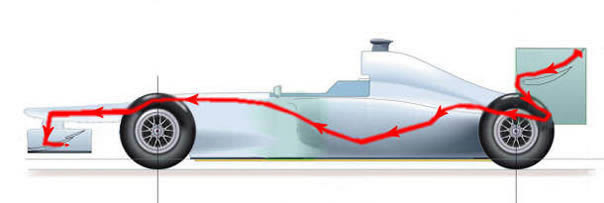
And all the others will have to move their DRS actuation system. On the Mercedes it's in the rear-wing end plates, which is what allows them to have the hole, which otherwise is illegal. The others all have theirs in the centre of the wing.
Whether it is deemed legal or not, you have to love this kind of tweaking and stretching of the rules. And by Ross Brawn, the master of the double diffuser.






